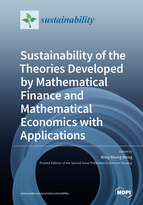Sustainability of the Theories Developed by Mathematical Finance and Mathematical Economics with Applications
A special issue of Sustainability (ISSN 2071-1050).
Deadline for manuscript submissions: closed (30 September 2019) | Viewed by 76958
Special Issue Editor
2. Department of Medical Research, China Medical University Hospital, Taichung City 40447, Taiwan
3. Department of Economics and Finance, The Hang Seng University of Hong Kong, Hong Kong, China
Interests: behavioral models; mathematical modeling; econometrics; energy economics; equity analysis; investment theory; risk management; behavioral economics; operational research; decision theory; environmental economics; public health; time series analysis; forecasting
Special Issues, Collections and Topics in MDPI journals
Special Issue Information
Dear Colleagues,
Mathematical Finance and Mathematical Economics play a vital role in many fields in the sustainability of Economics and Finance. In particular, they provide the theories and tools that have been widely used in all areas of economics and finance.
Knowledge of mathematics, probability, and statistics is essential to develop economic and finance theories and test their validity through the analysis of empirical real-world data. For example, mathematics, probability, and statistics could help to get sustainable monetary and fiscal policies, and to develop pricing models for financial assets such as equities, bonds, currencies, and derivative securities.
A Special Issue of Sustainability of the theories developed by Mathematical Finance and Mathematical Economics with Applications edited by Wing Keung Wong will be devoted to advancements in the
Sustainability of the theories developed by Mathematical Finance and Mathematical Economics with Applications in the areas of economics and finance. This Special Issue will also bring together practical, state-of-the-art applications of mathematics, probability, and statistical techniques in economics and finance and their sustainability.
We invite scholars to contribute original research articles that advance the use of mathematics, probability, and statistics in the areas of economics and finance and their sustainability. All submissions must contain original unpublished work not being considered for publication elsewhere.
References:
Bai, Z.D., Hui, Y.C., Wong, W.K., Zitikis, R., 2012. Prospect performance evaluation: Making a case for a non-asymptotic UMPU test. Journal of Financial Econometrics, 10(4), 703-732.
Bai, Z.D., Liu, H.X., Wong, W.K., 2009. Enhancement of the applicability of Markowitz’s portfolio optimization by utilizing random matrix theory. Mathematical Finance, 19(4), 639-667.
Egozcue, M., Fuentes García, F., Wong, W.K., Zitikis, R. 2012. Integration–segregation decisions under general value functions: ‘Create your own bundle—choose 1, 2, or all 3! IMA Journal of Management Mathematics, 1 of 16, doi:10.1093/imaman/dps024
Guo, X., Wagener, A., Wong, W.K., 2018. The Two-Moment Decision Model with Additive Risks, Risk Management 20(1), 77-94.
Lam, K., Liu, T.S., Wong, W.K. (2010), A pseudo-Bayesian model in financial decision making with implications to market volatility, under- and overreaction, European Journal of Operational Research 203(1),166-175.
Li, Z., Li, X., Hui, Y.C., Wong, W.K. 2018. Maslow Portfolio Selection for Individuals with Low Financial Sustainability, Sustainability 10(4), 1128; https://doi.org/10.3390/su10041128.
Matsumura, E.M.,Tsui, K.W., Wong, W.K. (1990), An Extended Multinomial-Dirichlet Model for Error Bounds for Dollar-Unit Sampling, Contemporary Accounting Research, 6(2-I), 485-500.
Wong, W.K., 2007. Stochastic dominance and mean-variance measures of profit and loss for business planning and investment. European Journal of Operational Research, 182(2), 829-843.
Wong, W.K., Ma, C., 2008. Preferences over location-scale family. Economic Theory, 37(1), 119-146.
Xu, R., Wong, W.K., Chen, G., Huang, S. 2017, Topological Characteristics of the Hong Kong Stock Market: A Test-based P-threshold Approach to Understanding Network Complexity, Scientific Reports 7, 41379, doi:10.1038/srep41379
Prof. Wing-Keung Wong
Guest Editor
Manuscript Submission Information
Manuscripts should be submitted online at www.mdpi.com by registering and logging in to this website. Once you are registered, click here to go to the submission form. Manuscripts can be submitted until the deadline. All submissions that pass pre-check are peer-reviewed. Accepted papers will be published continuously in the journal (as soon as accepted) and will be listed together on the special issue website. Research articles, review articles as well as short communications are invited. For planned papers, a title and short abstract (about 100 words) can be sent to the Editorial Office for announcement on this website.
Submitted manuscripts should not have been published previously, nor be under consideration for publication elsewhere (except conference proceedings papers). All manuscripts are thoroughly refereed through a single-blind peer-review process. A guide for authors and other relevant information for submission of manuscripts is available on the Instructions for Authors page. Sustainability is an international peer-reviewed open access semimonthly journal published by MDPI.
Please visit the Instructions for Authors page before submitting a manuscript. The Article Processing Charge (APC) for publication in this open access journal is 2400 CHF (Swiss Francs). Submitted papers should be well formatted and use good English. Authors may use MDPI's English editing service prior to publication or during author revisions.
Keywords
- Sustainability
- Mathematical Finance
- Mathematical Economics
- Applications






